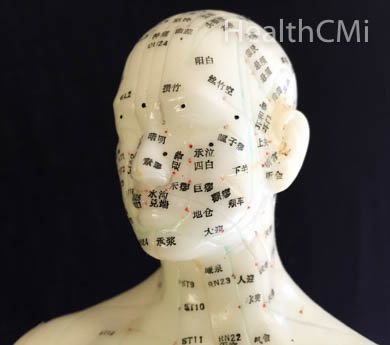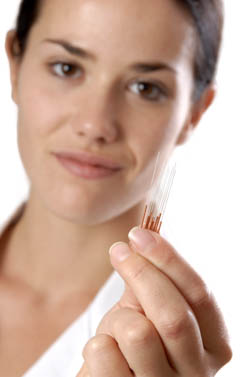Acupuncture reduces blood pressure for patients with prehypertension and stage 1 hypertension. Researchers investigated patients with mild hypertension to determine the efficacy of acupuncture in combating high blood pressure.  Acupuncture successfully reduced both systolic blood pressure (SBP) and diastolic blood pressure (DBP) after 8 weeks of acupuncture treatments.
Acupuncture successfully reduced both systolic blood pressure (SBP) and diastolic blood pressure (DBP) after 8 weeks of acupuncture treatments.
The study measured an acupuncture group and a control group receiving no treatment. The baseline blood pressure for the acupuncture patients was 137.1 / 86.4 prior to treatment. The researchers note, “In this study, acupuncture decreased SBP and DBP by approximately 6.0 and 5.7 mmHg, respectively, suggesting its potential benefits for patients with prehypertension and stage 1 hypertension.” Based on their findings, the researchers suggest that the duration and frequency of acupuncture treatments for hypertension should be at least 4 weeks at a rate of 2 or more times per week.
The researchers note that the diastolic blood pressure and HRV heart rate variability) indices improved significantly. HRV measures the change in time interval between heart beats and is an index of the body’s ability to maintain control of the heart beat rate and rhythm through vagus nerve activity. In this study, the high frequency component of HRV demonstrated significant improvements after 8 weeks of acupuncture treatments. The control group did not show significant HRV improvements.
Citing Fagard et al. and Singh et al., the researchers note that hypertension patients have low HRV. As a result, HRV indices are often employed in anti-hypertension therapy research. The researchers note that HRV increased significantly after 8 weeks of acupuncture treatments “which indicates an increase in parasympathetic activity in the acupuncture group.”
The acupuncture group received 20 minute acupuncture treatment sessions at a rate of 2 times per week for 8 weeks. After an additional 4 weeks following completion of the treatment regimen, a follow-up investigation was performed to confirm the results. A protocolized acupuncture treatment received approval for the study by Deajeon University’s Dunsan Oriental Hospital institutional review board. Randomization and blinding was used to reduce bias.
All patients admitted to the study were required to have only mild hypertension. Patients with systolic blood pressure greater than 160 mm Hg or diastolic blood pressure greater than 100 mm Hg were excluded from the investigation. However, the researchers cited numerous studies demonstrating the efficaciousness of acupuncture for patients with more severe cases of hypertension.

All acupuncture needles were disposable stainless steel filiform needles of 0.20 mm x 30 mm made by DongBang Acupuncture, Inc. located in Seoul, South Korea. Based on a consensus of 4 experts after a literature review, a strict protocolized acupuncture point prescription was devised taking into account traditional oriental medical theory. In normal clinical practice, an acupuncturist customizes the acupuncture point prescription to an individual’s medical needs, however, a protocolized set of acupoints is not unusual in research. The acupuncture points chosen for all patients were:
- ST36 (Zusanli)
- PC6 (Neiguan)
- LR3 (Taichong)
- SP4 (Gonsun)
- LI11 (Quchi)
The research demonstrates improvements in both blood pressure and HRV indices. As a result, the investigators suggest additional large scale studies to confirm the findings. The researchers note that the results suggest that acupuncture has potential in the clinical reduction of blood pressure for patients with prehypertension and stage 1 hypertension.
Xie et al. had similar findings. Acupuncture was found effective for reducing hypertension and acupuncture outperformed Capoten, an ACE (angiotensin-converting enzyme) inhibitor medication used for the regulation of hypertension. Acupuncture points used in the study were:
- Hegu (LI4)
- Taichong (LR3)
- Quchi (LI11)
- Xingjian (LR2)
The acupuncture patients demonstrated several other improvements including reductions in dizziness, pain of the knees and waist, and palpitations. Patients in this study had a combined diagnosis pattern as the inclusion criteria. All patients were required to have the biomedical condition of hypertension combined with the Traditional Chinese Medicine (TCM) condition of yin deficiency with yang uprising. The researchers discovered that acupuncture was more effective than the ACE inhibitor medication for these pateints.
References:
Liu, Yan, Ji-Eun Park, Kyung-Min Shin, Minhee Lee, Hee Jung, Ae-Ran Kim, So-Young Jung, Ho Ryong Yoo, O. Sang Kwon, and Sun-Mi Choi. "Acupuncture lowers blood pressure in mild hypertension patients: A randomized, controlled, assessor-blinded pilot trial." Complementary Therapies in Medicine (2015).
Fagard RH, Pardaens K, Staessen JA. Relationships of heart rate and heart rate variability with conventional and ambulatory blood pressure in the population. J Hypertens. 2001;19(3):389-397.
Singh JP, Larson MG, Tsuji H, Evans JC, O'Donnell CJ, Levy D. Reduced heart rate variability and new-onset hypertension: insights into pathogenesis of hypertension: the Framingham Heart Study. Hypertension. 1998;32(2):293-297.
Xie, B., and Y. P. Lin. "[Efficacy observation on acupuncture for essential hypertension of yin deficiency due to yang hyperactivity pattern]." Zhongguo zhen jiu= Chinese acupuncture & moxibustion 34, no. 6 (2014): 547-550.


